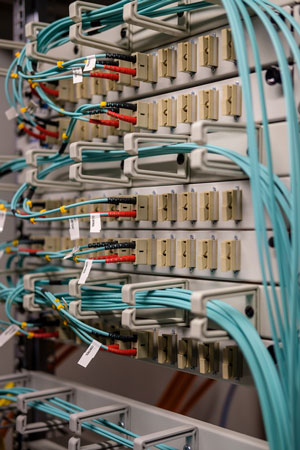If you are running a business and your broadband connections are driving you crazy, you may want to take a look at an alternate solution called dedicated point to point lines. Let’s have a look at what they are and what they can do for you.
 What Does Dedicated Mean?
What Does Dedicated Mean?Dedicated means that the bandwidth you are paying for is dedicated to your operations only.
But isn’t all bandwidth dedicated if you pay for it?
This is where it gets a little tricky. If you look closely at what broadband providers offer, they say something like “bandwidth up to 300 Mbps” or a similar disclaimer. Yes, the service you bought is capable of running at 300 Mbps. When you run a speed test, you may well see it clock-in at 300 Mbps… but not necessarily every time you test.
Why is that? It is because the bandwidth you got for such a bargain price is shared, not dedicated. You and multiple other users, including other businesses and consumers, are all connected to the same access line. When demand is low, you get screaming speeds. When everybody wants to download or upload files at the same time, that available bandwidth will be divvied up fairly so that everybody gets a share but nobody gets the line all to themselves. You might be waiting a bit.
If you want the line all to yourself and your business, you need to order a dedicated service. With dedicated bandwidth there won’t be other users outside of your organization competing for your line bandwidth. Whatever you aren’t using at the moment simply sits there idle for the time being.
You can greatly improve the stability of your Internet service with what is called DIA or Dedicated Internet Access. That’s a dedicated line from your company to your Internet Service Provider, where it connects to the Internet itself.
Will that guarantee smooth performance? Not really. Remember that the Internet is a shared service by its nature. There will be congestion and failure points from time to time no matter how you connect. The next step up is dedicated point to point fiber service.
Dedicated Point to Point Fiber
Dedicated lines have been available for decades using copper pairs and legacy telecom fiber called SONET for Synchronous Optical NETwork. Nowadays the best value is Ethernet over Fiber or EOF.
Fiber optic Ethernet services, sometimes called Metro Ethernet Fiber, are directly compatible with your servers using standard Ethernet interfaces. Unlike the Internet, you specify what two locations you want connected. The provider installs ports at each location and you have an always-on dedicated point to point fiber connection between them. You can order service starting at 10 Mbps or 100 Mbps and go up to 10 Gbps easily. In metro areas 100 Gbps bandwidth is available if you need it.
Advantages of dedicated point to point or P2P lines include solid bandwidth that is not affected by what other customers are doing. The link is inherently more secure than the Internet because there is no public access. Your bandwidth is usually symmetrical, meaning that it is the same for upload and download. That’s important if you are accessing remote servers to upload and download large files. Most shared bandwidth services are asymmetrical with download speeds typically 10x what you get for upload.
What are good uses for dedicated P2P fiber? The traditional application is linking multiple business locations. You may want to connect your headquarters and branch offices on the same private network so that someone across the country seems like they are just down the hall. Remote servers in colocation facilities or your own remote data center can also benefit from “extending the LAN” using dedicated P2P. Today that’s extended to the cloud, be it public, private or hybrid cloud services.
Do you need the stability and performance that dedicated point to point fiber line services can provide? If so, find out what fiber optic services are available for your business locations.

